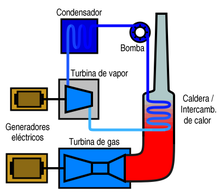THERMAL (NON-NUCLEAR) POWER PLANT
|
In a thermal power plant the chemical energy contained in fuels is converted into thermal energy and the into electricity. In these plants there is a boiler in which steam is produced by burning oil (fuel), natural gas or coal. The steam at high pressure, as in a nuclear power plant, is used to produce mechanical energy to drive turbines which are connected to the generator rotor and thus produce energy. |
 |
While conventional thermal plants are producing most of the lectricity we consume, they also pose problems and unavoidable environmental risks, of which the most important one is the problem of wastes.
Non-nuclear power plants produce three types of waste, each of which results in a different environmental problem:
- First, they contribute to air pollution, generating suspended particles, heavy metal molecules and various gases such as carbon monoxide.
- In addition, they emit large amounts of CO2, which increases the greenhouse effect, with serious umpredictable consequences.
- Finally, power plants emit sulfur oxides and nitrogen gases which cause acid rain, which cand be davastating to forests, waters of rivers and lakes, monuments...